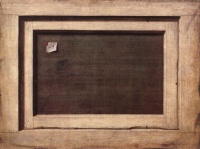Imaginary painting
From The Art and Popular Culture Encyclopedia
| Revision as of 17:16, 12 October 2012 Jahsonic (Talk | contribs) (→See also) ← Previous diff |
Revision as of 17:17, 12 October 2012 Jahsonic (Talk | contribs) Next diff → |
||
| Line 1: | Line 1: | ||
| + | [[Image:Ancient Rome (1757) by Giovanni Paolo Panini.jpg|thumb|right|200px|''[[Ancient Rome (painting)|Ancient Rome]]'' (1757) by [[Giovanni Paolo Panini]], a real painting filled with [[imaginary painting]]s of actual Roman antiquities.]] | ||
| [[Image:The Experts, 1837 by Alexandre-Gabriel Decamps.jpg |thumb|200px|''[[The Experts]]'' ([[1837]]) by [[Alexandre-Gabriel Decamps]]. The monkeys are inspecting a fictional painting.]] | [[Image:The Experts, 1837 by Alexandre-Gabriel Decamps.jpg |thumb|200px|''[[The Experts]]'' ([[1837]]) by [[Alexandre-Gabriel Decamps]]. The monkeys are inspecting a fictional painting.]] | ||
| [[Image:Reverse Side Of a Painting.jpg|thumb|right|200px|''[[Reverse Side Of a Painting]]'' (1670) by [[Cornelis Norbertus Gysbrechts]]. Is the [[Recto and verso |verso]] of a fictional painting?]] | [[Image:Reverse Side Of a Painting.jpg|thumb|right|200px|''[[Reverse Side Of a Painting]]'' (1670) by [[Cornelis Norbertus Gysbrechts]]. Is the [[Recto and verso |verso]] of a fictional painting?]] | ||
Revision as of 17:17, 12 October 2012
_by_Giovanni_Paolo_Panini.jpg)

|
Related e |
|
Featured: |
A fictional painting or an imaginary painting is a painting which exists in a fictitious world. It may also refer to paintings or drawings that depict fictitious worlds. This page functions as a placeholder for various links.
Contents |
Examples of paintings that only exist in a fictitious world
In literature
The work Eikones by Philostratus, a description of 64 paintings, is held by some of actually existing works of art, while others claim that they are imaginary paintings.
In Interpretazioni veneziane, Michelangelo Muraro and David Rosand state that:
- Certainly the imagery that Aretino describes at the beginning of the Passion carries conviction. ... has stimulated commentators to suggest that Aretino is describing an imaginary painting by Titian or Tintoretto. ...
Nicholas Meyer's 1993 novel The Canary Trainer describes a fictional painting by the famous Impressionist Degas, which happens to show Sherlock Holmes.
In painting
- Ancient Rome (painting) by Panini
- Some gallery painting are not of real galleries
In film
- Brush with Fate (2003), a a made-for-TV film. which follows the life of an imaginary painting by Dutch painter Johannes Vermeer.
Paintings that depict imaginary, fictitious worlds and creatures
Michelangelo in Da Pintura Antiga (1548) remarks on painting imaginary beings:
- "But if it so happens ... a work ... under pain of otherwise becoming shameful or false, requires fantasy ... [and that] certain limbs or elements of a figure are altered by borrowing from other species, for example transforming into a dolphin the hinder end of a griffon or a stag ... these alterations will be excellent and the substitution, however unreal it may seem, deserves to be declared a fine invention in the genre of the monstrous.
- When a painter introduces into this kind of work of art chimerae and other imaginary beings in order to divert and entertain the senses and also to captivate the eyes of mortals who long to see unclassified and impossible things, he shows himself more respectful of reason than if he produced the usual figures of men or of animals." --tr. from Monsters of Our Own Making: The Peculiar Pleasures of Fear by Marina Warner.
The practice should be contrasted with realism (visual arts).
See also
- Fact and fiction
- Imaginary
- Fictional
- Fictional book
- Painting
- Fancy portrait
- Historical landscape
- Imaginary museum


